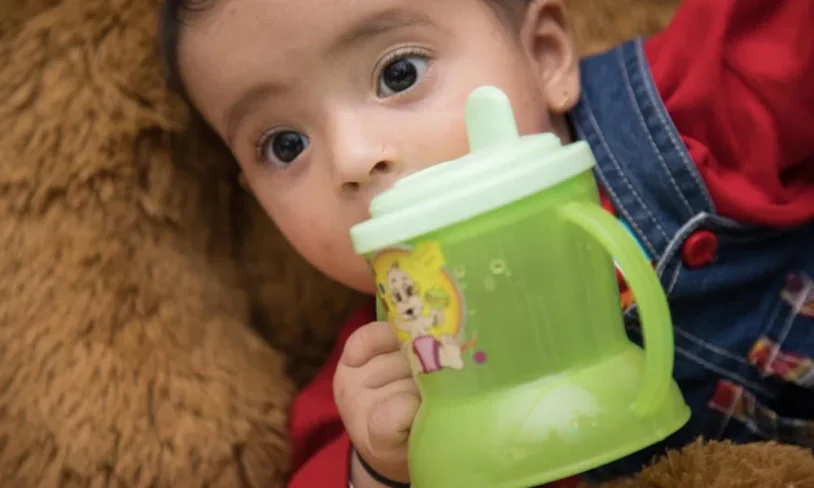You've probably heard that when your baby is around 6 to 9 months old, it's time to begin moving away from bottle feeding. But like many parents, you may feel a little apprehensive about this next step in your child's growth and development.
If your little one pouts, shouts or bursts into tears when you offer them a "big kid cup," take a deep breath. Protests like these are totally normal! After all, little humans don't like letting go of familiar habits any more than we do. And the comfort they get from sucking on a warm bottle can be hard to give up.
Like all growth stages your child will pass through, this one takes patience and time. But there are many good reasons not to give in when your child demands a bottle.
Why prolonged bottle feeding can cause health problems?
Pediatricians and dentists stress the benefits of training your child to drink from a cup at mealtime as you gradually reduce the number of bottle feedings. Ideally, this transition will begin around 6 months, when you offer your child a cup for the first time. You will then reduce the number of bottle feedings slowly, completing the transition sometime between 12 and 18 months.
Letting children bottle-feed longer than this can cause them to:
- Skip meals. Little ones who sip on bottles during the day often don't feel hungry at mealtimes. This may mean they're getting less of the fiber and rich nutrients found in solid foods. If you're begging your child to eat, bottles might be the cause.
- Reach an unhealthy weight. For many kids, bottles become high-calorie meal supplements and snacks, leading to toddler obesity. And while many people find chubby toddlers adorable, pediatricians point out that early obesity sets the stage for weight (and health) problems later in life.
- Develop cavities. Early childhood caries, sometimes called "baby bottle tooth decay" or baby tooth cavities, happen when your child's teeth are constantly bathed in milk, formula, juice or other drinks. Little ones who drink from bottles well into their second year may also have tooth alignment problems and even speech delays, since little mouths need to strengthen the muscles for clear speech.
- Resist even more. Toddlers cling to their bottles even more fiercely as time goes by. This can trigger a major power struggle between you and your child, so starting early is the healthiest path for both of you.
Tips for a smoother transition to drinking from a cup
The American Academy of Pediatrics (AAP) recommends that you offer your child a cup when they start eating solid foods, usually around 6 months. You can use a "sippy" (training) cup with a spouted lid or offer a cup and straw. Some children may choose to drink from an open cup without a straw – and that's just fine, too.
- Sippy cups should be used only while little ones are learning. It's healthiest for kids to drink from an open cup by about 2 years of age. (If your child has a chronic illness, physical differences or shows signs of small motor skill delay, ask your pediatrician to help you put together a schedule that follows your child's abilities.) When your child is using a sippy cup, only fill them with plain fluoridated water without juice or sugar.
- Move away from the bottle gradually. When you begin weaning, tell your child they can drink from a bottle at mealtimes. Gradually eliminate bottle feedings at other times, especially naps or bedtime. Be ready to offer extra snuggles, songs or bedtime stories so your child feels reassured, but learns to self-soothe without a bottle. Giving your child plain water in bottles between meals and then moving to plain water in sippy cups or cups can help with the transition.
- Start offering a cup to your child as early as 6 months. Bring one to the table with your child's plate and encourage them to give it a try. Begin by putting formula or breast milk in their cup—whatever they're drinking already. (This might feel more natural than starting with water.) As they get the hang of things, you can fill their cup with plain water at mealtimes, too.
- Celebrate their success. Notice your little one's progress and offer them praise. If it feels right, put on party hats and sing a happy tune. Your child is eating and drinking like a big kid, which helps set the stage for lifelong health. Hooray!
- If your child balks, do a little investigating. Maybe they aren't thirsty when you offer them a mealtime drink, and that's okay. Model good habits by drinking water when you eat together. If they seem to need a little more attention, don't hold back. "Wow, you took a sip! Good job! I love seeing you drink from your big-kid cup."
- Bring everyone into the act. Let daycare providers, sitters, grandparents, siblings and friends know that your child is building a new skill. Other caregivers need to follow the same routine so your child can move forward.
To continue reading about transitioning to a sippy cup, including tips for breastfed babies, CLICK HERE.


